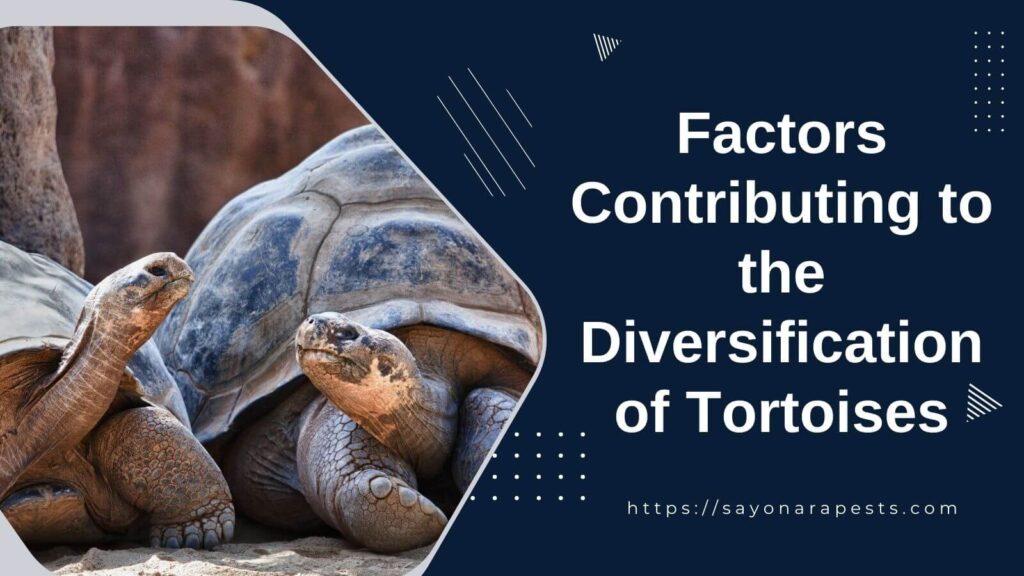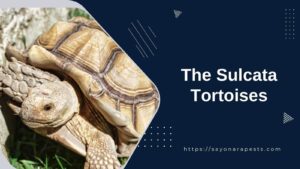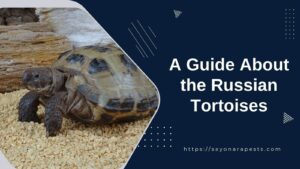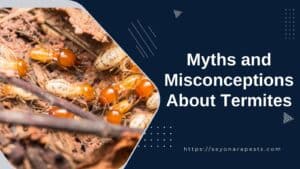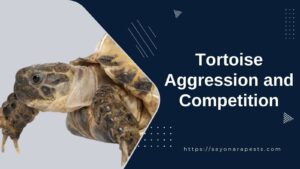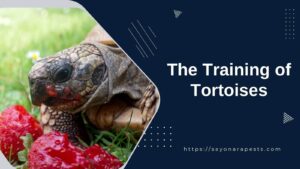Tortoises are interesting animals because they have hard shells and live slowly. They have piqued the interest of both scientists and nature lovers. Their long history and amazing ability to change have helped them do well in many different places around the world.
But scientists haven’t been able to figure out what caused these mysterious reptiles to become so different. It’s a mystery wrapped in a web of complexity and intrigue.
Tortoises have evolved into a wide variety of shapes and ways of life because of how their genes, the environment, and the pressures of evolution all work together.
By figuring out how they changed, you can not only learn more about how these charismatic reptiles evolved, but you can also learn more about how speciation and adaptation work in general.
So, the goal of this article is to delve into the complex world of tortoise diversification. It will look at the importance of tortoises’ journey through evolution and shed light on the forces that have led to their amazing diversity.
Get ready for a fascinating trip through the tortoise’s long history, which is like a maze where perplexity and wonder meet at every turn.
Natural Factors Contributing to the Diversification of Tortoises
Geographic Isolation
Geographic isolation is one of the most important things that has led to the evolution of different kinds of tortoises over time. These ancient reptiles are known for being slow and steady, but they have been anything but slow when it comes to adapting and changing.
One of the main things that lead to tortoise diversity is that geographic barriers are physically separate populations. Because they can’t move around very well, tortoises are more likely to become isolated when mountains, rivers, or oceans make it hard for them to get around.
When tortoises move away from other populations, they face different environmental conditions and different forces of natural selection than their counterparts in other areas.
Over time, these isolated populations experience genetic drift and build up genetic differences that can cause big changes in their appearance, behavior, and how their bodies work.
The lack of gene flow between these isolated populations stops the exchange of genetic material and encourages divergence, which can lead to the birth of new tortoise species or subspecies.
Habitat Diversity
Tortoises live in many different kinds of places on different continents, from deserts and grasslands to tropical rainforests and coastal areas. They have changed because of how many different kinds of places they can live.
Tortoises have adapted to their specific ecological niches because each environment gives them different challenges and chances to stay alive.
There are many ways that habitat diversity helps tortoises change. First, the kinds of food that are available in different habitats affect what tortoises like to eat and how they look for food.
For example, tortoises in dry areas have adapted to get water from succulent plants more efficiently, while those in forests may have a special diet of fruits, leaves, and mushrooms.
These changes help tortoises live in their own environments, but they also help different species become different as they learn to eat different things.
Second, the kind of environment a tortoise lives in affects its shape and shell. Tortoises that live in rocky areas often have a high-domed shell to protect them from falling rocks.
Tortoises that live in grasslands, on the other hand, may have a flatter shell to make it easier for them to move around. Tortoises in different environments have different shapes and sizes of shells because of natural selection, which helps them stay alive and have more babies.
Climate Variation
Changes in climate are another important natural factor that has led to the diversity of tortoises. These reptiles live in many different kinds of climates, from hot and dry to cool and wet.
Changes in temperature, rain patterns, and seasons in different parts of the world have affected how tortoises have evolved and contributed to their wide variety.
Tortoises have changed their bodies and behaviors in different ways to deal with the weather in their environments.
For example, tortoises that live in dry areas have learned to save water in smart ways, like being able to store water in their bladders or go into burrows when it’s very hot.
Tortoises in more temperate areas, on the other hand, may sleep through the winter to save energy and stay alive in harsh conditions.
Also, changes in climate have an effect on how and when tortoises reproduce and breed. Some species can tell the gender of their offspring based on the temperature of the environment while the egg is being incubated.
Because of this change, tortoises can change how they reproduce based on the weather, which increases their chances of having healthy babies and staying alive.
Tortoises have changed a lot because of natural things like how far apart they are from each other and how different their habitats are. Geographic barriers separate populations, which causes their genes to change.
Different habitats offer different ecological niches and selective pressures, which cause changes in diet, shape, and behavior. Also, changes in climate have affected the way tortoises live and reproduce, which has affected their evolution.
Because of how these factors affect each other, there are many different kinds of tortoises today. This shows how adaptable and tough these ancient reptiles are.
Behavioral Factors Contributing to the Diversification of Tortoises
Dietary Variation
The way tortoises eat is a big reason why they have so many different kinds. These reptiles eat in a wide variety of ways that show how well they can adjust to different environments and food sources.
Some species of tortoise, called herbivores, eat mostly plants like grasses, leaves, and fruits. Their digestive systems have become very good at breaking down fibrous plant matter, which lets them get the nutrients they need.
Other species of tortoise, on the other hand, are omnivores, which means they eat both plants and small animals. This gives them access to a wider range of food sources and makes it more likely that they will survive in harsh environments.
Because tortoises can get food from many different places, their bodies have become more specialized. For example, herbivorous tortoises usually have sharp, serrated jaws that make it easy for them to cut up plants.
Omnivorous tortoises, on the other hand, usually have jaws that are more flexible and can handle a wider range of foods.
This variety in what tortoises eat has been a key factor in how they have changed over time, leading to different species with different eating habits and adaptations.
Reproductive Strategies
The way tortoises reproduce is another important behavioral factor that has led to their diversity. Different species have developed different ways to reproduce, which help them do well in different environments and have the most successful offspring possible.
Tortoise populations have different ways of mating, which is a good example. Some species mate with more than one female at a time. When this happens, males compete for access to more than one female, which leads to a lot of sexual selection.
Because of this competition, males often develop elaborate courtship displays, physical traits, or behaviors that make them more appealing to potential mates.
Other tortoise species, on the other hand, are either monogamous or promiscuous, meaning that individuals form long-term pair bonds or have many short-term relationships. These strategies are used in environments or habitats that are more stable or have a lot of resources.
Different selective pressures act on populations, favoring certain traits or behaviors that increase reproductive fitness. This leads to genetic differentiation and species formation.
Social Behavior
Tortoises have also changed in a lot of ways because of how they act in groups. Tortoises were once thought to be solitary animals, but recent research has shown that some species have complex social interactions and form groups, especially at certain stages of their lives.
For example, hatchling tortoises often gather in large groups called “aggregations.” This helps them avoid being eaten by predators, keep their bodies at the right temperature, and share information.
These groups not only help people stay alive, but they also make it easier for people to learn and share important information.
Also, adult tortoises may have a sense of territory and protect places that have important resources like food, water, and shelter. Territoriality often leads to the formation of hierarchies within populations.
Dominant individuals claim and protect the best habitats, while subordinate individuals live in places that aren’t as good.
This social structure has an effect on the evolution of tortoises because it can change how genes move, how they move around, and how subpopulations with different genes form.
Tortoises have a lot of different kinds because of how they act in different situations. Tortoises change their bodies to eat different kinds of food because their diets are different.
Some of the things that contribute to genetic differentiation and speciation are mating systems and sexual selection. Lastly, survival, learning, and the formation of subpopulations are all affected by social behavior, such as aggregations and territoriality.
By looking at these factors, we can learn more about the complex and fascinating world of tortoise diversification. This can help us figure out how these ancient reptiles have changed over time.
Genetic Factors Contributing to the Diversification of Tortoises
Mutation
Mutation, which is when DNA sequences change on their own and at random, is one of the most important things that causes genetic variation in tortoises.
Mutations can happen when DNA replication goes wrong, when DNA is exposed to environmental factors like radiation, or when other genetic mechanisms go wrong.
Tortoises have become more different over time because of these changes to their genes, which can add new traits or change the ones they already have.
Mutations can change anything from a single nucleotide to the whole structure of the genome. These mutations can change many things about a tortoise’s life, like the shape of its shell, its color, or how it reproduces.
For example, a mutation that changes the way genes involved in shell development are expressed can cause different tortoise species to have shells with different patterns or sizes.
Hybridization
Another genetic factor that contributes to diversification is hybridization, which is when different species of tortoise mate with each other. When two tortoise species that are closely related meet and are able to mate, their genes mix, and hybrid offspring are born.
These hybrids often have a unique mix of traits from both parent species. This can lead to the development of new tortoise lineages.
Hybridization can happen naturally when there are no geographical barriers or when people do things like damage their habitats or put them together on purpose to breed.
By mixing genes from different species, hybridization can create new genetic variations that help hybrid populations adapt to new environments or fill ecological niches that neither parent species can.
Over time, these hybrid tortoises may change into separate groups of tortoises with different genes.
Natural Selection
Natural selection is a strong force of evolution that acts on the different genes in a population of tortoises. Tortoises that have good genes that help them live longer and have more babies are more likely to pass those genes on to their offspring.
Because of this, these good traits become more common in the population, which helps tortoises become more diverse and adapt to different environments and ecological niches.
Tortoises can change in many ways because of natural selection. For example, in places where there are many different kinds of food, tortoises with beaks or jaws that are better suited for certain foods are more likely to live and have babies.
Over time, this can cause different groups of tortoises to grow up that only eat certain kinds of food.
Also, natural selection can have an effect on other parts of a tortoise’s life, like how it deals with temperature, how it avoids predators, or how it reproduces.
People with these traits are more likely to live and pass them on to future generations if their genes give them an advantage in these areas. Because of this, tortoise populations can develop their own genes and adapt to their own environments.
Tortoises have changed over time because of different genetic factors, such as mutation, hybridization, and natural selection. Mutations change the genes, and hybridization can lead to the birth of new tortoise lineages.
Natural selection acts on these genetic differences to favor traits that help tortoises live longer and have more babies.
This causes tortoises to change and adapt to their environments. Understanding these genetic factors gives us important information about the processes of evolution that have led to the wide variety of tortoises we see today.
Anthropogenic Factors Contributing to the Diversification of Tortoises
Habitat Fragmentation
Habitat fragmentation, a consequence of human activities such as deforestation, urbanization, and agricultural expansion, has emerged as a critical anthropogenic factor driving tortoise diversification.
Once contiguous habitats are now fragmented into isolated patches, impeding gene flow and promoting genetic differentiation among populations.
As tortoises become confined to smaller and increasingly isolated habitats, their ability to disperse and interact with individuals from different populations becomes severely restricted.
Consequently, genetic variation within species diminishes, increasing the likelihood of inbreeding and reducing the overall adaptive potential of tortoise populations.
Moreover, habitat fragmentation disrupts the intricate ecological balance that tortoises have evolved alongside over millennia. These reptiles play crucial roles in their ecosystems as seed dispersers, grazers, and engineers of habitats.
Fragmentation disrupts the mutualistic interactions between tortoises and their environment, leading to cascading effects on plant communities, nutrient cycling, and even other species that rely on tortoises for various ecological services.
The consequences of habitat fragmentation are thus far-reaching, jeopardizing the long-term survival and adaptability of tortoises.
Introduction of Exotic Species
Whether it was done on purpose or by accident, bringing in exotic species has had a big effect on how different tortoises are. Human actions have spread non-native species to many places, often with results that were not intended.
These exotic species can take resources away from native tortoises, eat their eggs or hatchlings, or bring in new diseases that native tortoises don’t have a natural defense against.
This intense competition and pressure from predators upset the delicate balance of ecological interactions that have grown over hundreds of years. This can lead to the extinction of native tortoises or force them to change quickly in order to stay alive.
The effects of exotic species on the environment are especially clear on islands, where tortoises have been living on their own for millions of years. These islands have ecosystems that are often unique and fragile.
This makes them very vulnerable to invasive species. The well-known case of the Galápagos Islands is a stark reminder of how invasive species can hurt tortoise diversity in terrible ways.
Rats, cats, and goats that people brought with them have killed off most tortoise populations and caused several species to go extinct.
This irreplaceable loss of biodiversity shows how important it is to take immediate steps to stop the introduction and spread of exotic species in order to protect the wide variety of tortoises.
Overexploitation
Overexploitation, which is happening because people want to eat them, use them as medicine, and sell them as pets, has become a major threat to the survival and diversity of tortoises. In the past, people hunted tortoises for their meat, shells, and other body parts.
This led to the decimation of populations and the extinction of some species. When tortoises are taken from the wild too often, it changes the way their population works, which affects their ability to reproduce and their genetic diversity as a whole.
Also, tortoises are even more vulnerable because they are often taken from the wild and sold as pets. This has led to unsustainable population declines and the illegal trade of protected species.
Overexploitation not only hurts tortoises, but it also hurts the ecosystems where they live. Tortoises are keystone species because they have a big effect on how plants grow, how nutrients move through the ecosystem, and even how often fires happen.
When tortoises leave an ecosystem, it can have a big effect on how the habitat is made up and how it works. This can set off ecological cascades that threaten the stability of whole ecosystems.
People have had a big impact on tortoise diversity through things like destroying their habitats, bringing in species from other places, and taking too many of them.
These things have not only affected how tortoises have changed over time, but they have also made it hard for them to stay alive and be protected.
For effective conservation strategies that aim to protect these amazing reptiles and the ecosystems they live in, it is important to understand how human activities and tortoise diversity interact with each other.
Species-specific Factors Contributing to Diversification of Tortoises
Morphological Variation
Morphological change is one of the main reasons why tortoises are so different from each other. These animals have a wide range of physical traits that have helped them live in many different kinds of environments around the world.
The Galapagos giant tortoise has a strong, armored shell, and species that live in the desert have slim bodies. These physical changes have helped tortoises do well in their different environments.
These differences in shell shape, size, and color are important for survival because they help animals hide from predators and move around more easily.
Tortoises have become very different over time because different populations have adapted to different environmental conditions by changing the way they look.
Behavioral Adaptations
In addition to physical changes, behavioral adaptations have been very important in the formation of tortoises. These reptiles have changed their behavior in a lot of different ways that have helped them live and reproduce in different places.
For example, some species of tortoise have complicated migration patterns and travel long distances to find food and places to nest. These behaviors not only let them use different resources but also make it easier for genes to move between populations.
This keeps them from becoming genetically isolated and helps them become more diverse. Also, tortoises have a wide range of ways to eat, from being herbivores to eating everything.
This has helped them fill different ecological niches and use different food sources. These changes in behavior have given tortoises the flexibility and versatility they need to adapt to changing environments and take advantage of new opportunities in the natural world.
Genetic Diversity
Tortoises have changed a lot over time, and genetic diversity is a big reason why. Both within and between species of tortoises, genetic differences are the building blocks of evolution.
It makes it possible to adjust to certain environmental conditions, fight off diseases, and develop unique traits. Through things like sexual reproduction and gene flow, tortoises have been able to keep a lot of genetic diversity in their populations.
Tortoises have been able to stay adaptable and strong in the face of environmental changes by encouraging genetic recombination and the exchange of genetic material between individuals and populations.
Tortoise species’ geographic distribution has also affected their genetic diversity. Isolated populations often have more genetic differences because there is less gene flow between them.
This change in how genes are organized has led to the development of new subspecies and even new species over time.
The different kinds of tortoises are the result of a complicated interaction between factors that are unique to each species. Tortoises have been able to live in different places and avoid being eaten by predators because they can change the shape and color of their shells.
Their migration patterns and eating habits, for example, have helped them take advantage of different ecological niches and ensured the survival of different populations.
Also, genetic diversity has given organisms the genetic material they need to adapt and evolve, which has led to the rise of new species and subspecies. The tortoise’s history of evolution has been shaped by all of these factors, which have come together in a complicated way.
This has made tortoises a unique group of reptiles that show how amazing biological diversity is.
Biogeographical Factors Contributing to the Diversification of Tortoises
Historical Biogeography
Historical biogeography is a key part of understanding how tortoises have changed over time because it shows how they have changed over time and what factors have changed where they live. The history of how tortoises have changed over millions of years is long and interesting.
Scientists have been able to figure out the historical biogeography of tortoises by looking at fossil records and using molecular techniques to learn more about where they came from and how they spread.
The main things that make up the history of tortoise biogeography are continental drift and the formation of land bridges. Due to the movement of tectonic plates, the Earth’s landmasses have changed a lot over the course of geological time.
Because of these changes, continents broke up and joined together, making barriers and paths for tortoises to move around. For example, when the supercontinent Pangaea broke up during the Mesozoic Era, tortoise lineages split up and now live on different continents.
Tortoises have also moved around a lot because of how land bridges have formed. When land bridges, like the Bering Land Bridge, linked land masses that had been separated, tortoises were able to move into new areas.
This made it possible for different populations to share genetic material and helped them become more diverse. But when these land bridges were covered by water, tortoise populations were cut off from each other, and different lineages developed.
Island Biogeography
Island biogeography has had a big effect on how tortoises have changed over time. Whether they are in the ocean or on land, islands are known for their unique ecological features and their isolation from habitats on the mainland.
Tortoises have been able to live on many islands around the world, and these isolated places have been good for adaptive radiation and species development.
When compared to mainland tortoises, island tortoises are often a very different size. This is because there aren’t many big predators on islands and there are a lot of resources there.
Tortoises on islands grew much bigger over time because they didn’t have to compete for food and there was plenty of it. This led to the development of giant tortoises in some areas.
For example, the Galapagos Islands are famous for their giant tortoises, which are often called the “flagship species” of the group of islands.
Island biogeography has also caused tortoises to have different shapes and colors of shells, in addition to different sizes. Because islands don’t have predators and have different kinds of selective pressure, they have different physical features.
Tortoises on the Aldabra Atoll in the Indian Ocean, for example, have dome-shaped shell that lets them reach high plants and make the most of their environment.
Biogeographic Regions
Biogeographic regions, which have different ecological and evolutionary traits, have had a big impact on how tortoises have changed over time.
Climate, geology, and topography, which are nonliving things, come together in different ways in each of these regions. This, in turn, affects how species move around and change over time.
For example, the Mediterranean Basin, which has a lot of different plants and animals, has been a very important biogeographic area for tortoises.
Tortoise species have found different places to live in the region’s different landscapes, from the coast to the mountains. Because of this, different genetic lines and adaptations to specific ecological niches have developed in the Mediterranean Basin.
In the same way, the biogeographic region of the Caribbean has had a big impact on how tortoises have changed over time.
Because of the many islands and different climates in this area, different species of tortoise have been able to develop and adapt to their own island environments. The Pacific biogeographic region, which includes the Galapagos Islands, is another great example.
The unique geological history and isolated ecosystems of the archipelago have led to a wide variety of tortoise species, each of which has adapted to the environment of its own island.
Tortoises have become different because of a complicated mix of historical biogeography, biogeography of islands, and biogeography of regions.
Tortoises have changed and spread because of how continents have moved, how to land bridges have formed and disappeared, and how islands have been settled.
Also, different biogeographic regions with their own unique ecological features have helped different tortoise lineages grow and change.
Understanding these biogeographical factors is important for figuring out how tortoises have changed over time and keeping their different populations safe from environmental problems.
Evolutionary Processes Contributing to the Diversification of Tortoises
Convergent Evolution
The first process being looked at, called “convergent evolution,” is a big reason why tortoises living in very different environments look so much alike.
Through convergent evolution, different lines of tortoises have independently come up with similar physical and physiological changes to help them deal with similar environmental challenges. This can be seen in how their hard shells have changed over time.
These shells are a strong defense against predators and environmental dangers. Even though they have different ancestors, tortoises from different places, like the Galápagos Islands and the deserts of North America, have shells that look a lot alike.
This shows how powerful convergent evolution can be in shaping adaptations.
Divergent Evolution
Divergent evolution, on the other hand, has played a big role in making the wide variety of tortoise species that exist today. Through this process, the tortoises’ ancestors have changed into different lines that have adapted to different ecological niches.
As tortoises moved into different environments, natural selection worked on them, favoring those with traits that fit the needs of their new home. Over time, these good traits spread through populations and became fixed.
This led to the rise of new species with different physical and biological traits. When you look at the giant tortoises of the Galápagos and the small tortoises that live on land in Madagascar, you can see that they have evolved in different ways.
The first group is huge and has a dome-shaped shell to help them survive on volcanic islands, while the second group is smaller and has a flatter shell to help it move through the dense vegetation of Madagascar’s forests.
This kind of divergence shows how quickly the tortoise lineage has changed and adapted, which has led to a lot of different species with specialized traits.
Coevolution
Coevolution, the last process being examined, has made a big impact on how tortoises and other organisms in their ecosystems interact with each other. Tortoises have changed along with many types of plants, especially those that they eat.
Tortoises eat plants, so the plants they eat are changed by the process of natural selection. This interaction leads to changes on both sides. For example, plants have developed ways to stop tortoises from eating too much of them or to help their seeds spread when they eat them.
In the same way, tortoises have adapted their bodies and bodily functions to make the most of the plants they can find. Some tortoise species, for example, have grown longer necks and limbs so they can reach higher plants.
Other species have grown stronger jaws and teeth so they can eat tougher plants. The interaction of coevolutionary forces between tortoises and their plant counterparts has led to complex and changing relationships that have helped to make their habitats more diverse and ecologically stable.
Tortoises have changed over time because of many different evolutionary processes, each of which has played a unique role in how they have adapted and become different species.
Convergent evolution has caused tortoises that live in similar environments to develop similar traits, while divergent evolution has caused tortoises that live in different environments to develop different traits.
Coevolution has also changed how tortoises and other organisms interact with each other. This has led to adaptations on both sides and complicated relationships in their ecosystems.
By learning more about how these evolutionary processes work, we not only learn more about how tortoises have changed over time, but we also learn more about the mechanisms that drive biodiversity in the natural world as a whole.
Role of Climate Change in Diversification of Tortoises
Historical Climate Change
The role of climate change in the evolution of tortoise species can be found in the annals of history, where geological records and fossils show how climate changed in the past and had a big impact on how tortoise species changed over time.
Over millions of years, the Earth’s climate has changed many times. There have been ice ages and times when it was warmer.
These changes have had a big effect on where tortoises live and how they adapt in different parts of the world.
During periods of cooling, like ice ages, a lot of the Earth’s surface was covered in ice, which made it harder for tortoises to find places to live. Because of this, small groups of tortoises grew up in pockets of good habitat.
Over time, these isolated populations’ genes changed because there wasn’t much gene flow between them, and they adapted in their own ways to survive in their own environments. This process, called allopatric speciation, was a key part of how tortoises changed over time.
On the other hand, when it got warmer, areas that tortoises could live in grew, so they could move to new places. This caused tortoises to move to places they hadn’t been before and made it easier for new species to form.
As tortoises lived in different kinds of environments, they were subjected to selective pressures that favored certain traits and ways of living.
This process, called “adaptive radiation,” also helped tortoises become more diverse by creating a wide range of species with different physical and ecological traits.
Current Climate Change
In recent years, it has become clearer and clearer how climate change affects the different kinds of tortoises. Climate change caused by people, which is mostly caused by the release of greenhouse gases, has caused temperatures to rise quickly and more than ever before.
This rise in temperature has big effects on tortoises and their habitats, causing big changes in where they live, how they act, and how many of them there are.
As temperatures rise, many species of tortoise are having to change where they like to live. The weather is changing, and this means that some species have to move or change in order to survive.
But the rate of climate change is often faster than the speed at which tortoises can change or move. This can cause population declines, local extinctions, and the splitting up of once-continuous populations.
This adds to genetic divergence and the possibility of new species forming.
Climate change is also changing more than just the temperature. It is also changing how it rains and how much water is available. Like many other reptiles, tortoises need certain levels of moisture to nest, go into hibernation, and drink.
Changes in the way it rains and periods of drought can mess up these important life processes, which can hurt the success of reproduction and the number of people who live.
Because of this, tortoises are finding it harder and harder to change their habits and adapt to changes in their environment.
Future Climate Change
Even though climate change is happening now, the future of tortoise diversity is still unknown and worrying. Projections show that global temperatures will continue to rise, which could mean that they will go above the limits that many tortoise species have adapted to.
This will probably make the problems they are already having worse and make it harder for them to diversify.
One possible outcome is that tortoises will have to change quickly or face a higher chance of going extinct. As climate change speeds up, tortoises’ ability to adapt may be put to the test in a big way.
Because of things like small population sizes, habitat fragmentation, and less gene flow, it may be hard for populations to make the genetic changes they need to stay alive.
So, the process of new tortoise species coming into being through the process of diversification could become more limited or even stop.
To lessen the bad effects of climate change on tortoise diversification, it’s important to have strategies for both preventing and responding to it.
To make tortoise populations more resilient, people need to work to reduce greenhouse gas emissions, protect and restore habitats, and build corridors to help species move around.
Also, captive breeding and translocation programs can help protect the genetic diversity of threatened species and give them a chance to survive and change.
In the end, the role of climate change in tortoise diversity is complicated and ongoing. Changes in the climate in the past have had a big effect on how tortoises have changed over time, through processes like allopatric speciation and adaptive radiation.
But human actions are causing climate change now and in the future, which is causing tortoises to face problems that have never been seen before.
Tortoises’ ability to adapt and change is being put to the test, which could affect their long-term survival and the creation of new species.
In a world that is changing quickly, we need to act quickly to reduce the effects of climate change and protect biodiversity and the ability of tortoises to evolve.
Implications of Diversification of Tortoises
Ecological Significance
The different kinds of tortoises have a big impact on ecosystems all over the world by changing and shaping them. Tortoises are known for moving slowly and eating plants.
This makes them important for spreading seeds. As tortoises move through their habitats, they eat plants and pass the seeds out of their bodies without breaking them.
This helps plants spread and helps new plant communities grow. As seed-spreaders, tortoises play a key role in maintaining biodiversity and making sure ecosystems can handle changes.
Also, by digging holes, tortoises create and change habitats, which makes them engineers of the ecosystem. Their burrows are homes for many different kinds of animals, such as small mammals, reptiles, and insects.
These burrows give animals a place to hide from predators and harsh weather, which helps the area’s biodiversity as a whole. Tortoises are becoming more diverse, and different species burrow in different ways.
This adds to the complexity of the ecosystem and gives other organisms places to live.
Economic Significance
In many ways, the different kinds of tortoises affect the economy. First of all, tortoises are popular pets in many parts of the world, so there is a need for those that have been raised in captivity.
Because of this, there are now programs to breed tortoises and businesses that focus on the trade and sale of these reptiles.
Different species of tortoises have different looks and behaviors, which adds to the value of the pet trade industry as people look for specific species and morphological variations.
Tortoises have also become popular attractions in zoos, wildlife parks, and nature reserves, which helps the tourism industry.
Having different kinds of tortoises in these places makes the experience better for visitors and gives them a chance to learn about the importance of biodiversity and conservation.
These attractions bring in money for the local economy through admission fees, sales of merchandise, and services for tourists.
Conservation Significance
The fact that tortoises are changing has big effects on conservation efforts all over the world. Many species of tortoise are in danger from many things, such as habitat loss, poaching, and illegal trade.
For the long-term survival of tortoises and the protection of their habitats, it is important to learn about and protect the different kinds of tortoises.
Scientists and conservationists can study and record differences in genetics, appearance, and behavior because there are many different kinds of tortoises.
This information is very important for making effective conservation plans, such as breeding programs in captivity, efforts to restore habitats, and measures to protect endangered species.
By keeping different populations of tortoises together, we can protect the genetic diversity of the species and keep ecosystems as a whole in good shape.
Also, the different kinds of tortoises bring attention to how important it is to protect biodiversity. Conservation efforts can get more attention and help from the public if they show how different tortoise species have adapted and what roles they play in their ecosystems.
This can lead to more money for conservation projects, more community involvement in conservation efforts, and changes in policy meant to protect tortoise habitats and cut down on the illegal trade in wildlife.
In this regard, the different kinds of tortoises have big effects on the environment, the economy, and conservation. As seed-spreaders and “ecosystem engineers,” they help keep ecosystems strong and full of different kinds of life.
Tortoise species diversity helps the pet trade and tourism industries financially. From a conservation point of view, keeping different tortoise populations is important to protect genetic diversity and help protect habitats.
Overall, if we want to protect and maintain the natural world, we need to be aware of and understand the effects of tortoise diversification.
Challenges and Opportunities in Conserving Diversification of Tortoises
Habitat Protection and Restoration
Tortoise conservation is a complicated and multifaceted process that has both challenges and opportunities. The goal is to protect the diversity of these amazing animals.
Tortoises need very specific ecosystems to live, so protecting and restoring their habitats is one of the most important things to do. As people do more things, deforestation, urbanization, and climate change are always a threat to natural habitats.
So, it is very important to come up with strong ways to protect tortoise habitats and bring back areas that have been damaged.
Efforts to protect habitats use many different methods, such as setting up protected areas like national parks and wildlife sanctuaries. Tortoises can feel safe in these designated areas, which keeps people from getting too close to them.
Also, habitat restoration projects try to fix up damaged ecosystems and make them a good place for tortoises to live and grow. This could include projects to plant more trees, fix up wetlands, and get rid of invasive species that upset the ecosystem’s delicate balance.
Conservationists can make environments that support tortoise populations and allow them to change by focusing on protecting and restoring habitats.
Species Monitoring and Management
Monitoring and managing species is another important part of saving tortoises. It is important to keep a close eye on tortoise populations so that their health can be checked, population trends can be tracked, and possible threats can be found.
This can be done in different ways, such as through field surveys, camera traps, and genetic analysis.
Conservationists can make sure that tortoises will live and change for a long time by collecting and analyzing information about population sizes, patterns of distribution, and genetic diversity.
Managing species means dealing with the specific problems that each species of tortoise faces. This means finding threats like habitat fragmentation, illegal trade, and predation and making them less dangerous.
For example, building wildlife corridors can link up fragmented habitats, making it easier for tortoises to move around and for genes to move between populations. Also, to stop illegal trade, laws need to be made stronger, law enforcement needs to get better, and more people need to know how bad the exotic pet trade is.
Conservationists can meet the unique needs of each tortoise species and help them grow by putting in place comprehensive monitoring and management programs.
Public Awareness and Education
Tortoises can only be saved if people know about them and learn about them. Many people don’t know the dangers tortoises face or how important it is to keep them alive.
So, raising public awareness is important if you want to get support and get people and communities to act.
Public education programs can include outreach programs, campaigns to raise awareness, and educational materials that show how important tortoises are to the environment and why they should be protected.
By getting people involved and letting them know how important it is to keep tortoise diversity, we can build a sense of stewardship and get everyone to work together to protect them.
In a broader sense, keeping the variety of tortoises alive comes with both problems and chances. By protecting and restoring habitats, we can make and keep places where tortoises can live and grow.
Monitoring and managing species let us deal with specific threats and put specific conservation plans into place. Awareness and education are important ways to get people to help and feel like they have a responsibility to protect these amazing animals.
We can protect the diversity of tortoises for future generations by facing these problems and taking advantage of opportunities.
In conclusion, tortoise diversification is a fascinating topic that involves a wide range of factors and processes. Understanding these complexities and what they mean is important for saving them and the rest of nature.
Future research should focus on filling in the gaps in what we know, looking into species and areas that haven’t been studied much, and figuring out how global changes might affect tortoise populations.
We can ensure the continued diversification and survival of these amazing creatures for future generations by accepting the challenges and opportunities that lie ahead.

